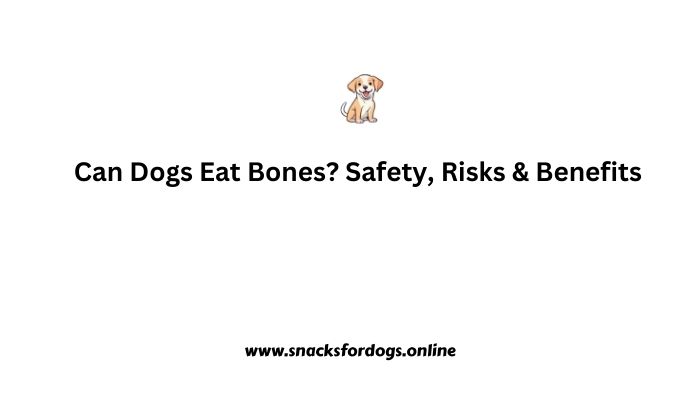Bones have nutrients and can help keep your dog’s teeth clean. But they can also be risky. Many experts don’t recommend giving bones to dogs. Cooked bones are especially dangerous because they can break into sharp pieces and cause choking. Vets warn that chewing bones may lead to serious health problems. It’s safer to give your dog healthy fruits instead.
Can I Give My Dog a Bone?
Raw bones are usually safer than cooked ones, but both can be risky. Cooked bones break easily into sharp pieces that can harm your dog’s mouth, throat, or stomach. Raw bones are softer, but they still carry risks like choking, infections, or blockages. Always watch your dog while they chew.
Dangers of Bones for Dogs
Chewing on bones—raw or cooked—can cause:
- Cuts in the mouth and throat
- Broken teeth
- Choking
- Vomiting or diarrhea
- Constipation
- Intestinal blockage or bleeding
Unsafe Bones for Dogs
- Cooked Chicken & Turkey Bones – These splinter easily and may get stuck in the throat.
- T-Bones – Their shape makes them a choking hazard and can block a dog’s airway.
- Small & Circular Bones – These can cause choking or even trap a dog’s lower jaw.
Safe Bones for Dogs
If you choose to give a bone, get a large raw bone from a butcher. It should be big enough for your dog to hold and have rounded ends. Refrigerate before use and throw it away after a few hours. Even raw bones can break teeth or cause digestive issues, so always supervise your dog.
Why Bones Can Be Harmful to Dogs (According to the FDA)
Bones can be dangerous for dogs, even raw ones. Here’s why:
- Broken Teeth – Bones are hard and can break teeth, leading to pain and expensive treatment.
- Mouth Injuries – Sharp bone pieces can cut the tongue, cheeks, or roof of the mouth.
- Bones Stuck in the Jaw – Round bones can get trapped behind the lower teeth, often requiring sedation to remove.
- Choking Hazard – Bone pieces can block the throat or windpipe, making it hard to breathe.
- Stomach & Intestinal Injuries – Sharp fragments can puncture the stomach or intestines, causing a deadly infection.
- Bones Stuck in the Stomach – Large pieces may not pass, leading to vomiting and irritation. Surgery may be needed.
- Intestinal Blockage or Constipation – Bone fragments can block the intestines, requiring surgery or enemas.
- Infection Risk – Raw bones can carry harmful bacteria like E. coli, Salmonella, and Listeria, which can make both dogs and humans sick.
Bone Safety Guidelines
If you give your dog a bone, follow these safety tips:
Choose raw meat bones.
Take the bone away after 10-15 minutes and refrigerate it.
Throw out the bone after 3-4 days.
Pick large bones for big dogs like German Shepherds or Mastiffs.
Always supervise your dog while they chew.
What NOT to Do
Never give cooked bones of any kind.
Don’t let your dog chew a bone into small pieces.
Avoid giving bones to dogs with stomach issues.
Don’t offer a bone when other dogs are around (it can lead to fights).
Note: This guide is for general information. Always ask your vet if you’re unsure.
FAQs
How Many Bones Do Dogs Have?
Dogs usually have 319 to 321 bones, depending on their breed and tail length.
How Many Bones Do Dogs Have in Their Feet?
Each paw has four large bones (metacarpals/metatarsals) and three smaller toe bones (phalanges).
Is a Dog’s Tail Made of Bone?
Yes, a dog’s tail contains vertebrae, making it flexible yet sturdy.
How Are Dog and Human Bones Different?
Dogs have stronger, denser bones built for four-legged movement, while humans have lighter bones suited for upright walking.
How Many Teeth Do Dogs Have?
Dogs have 42 strong teeth designed for chewing and tearing, unlike humans, who have 32 teeth for a varied diet.
How Do Bones and Muscles Work Together?
Muscles attach to bones with tendons. When a muscle contracts, it pulls the bone, creating movement.
What Are the Three Dog Head Shapes?
- Dolichocephalic (Long-headed, e.g., Greyhound)
- Brachycephalic (Short-nosed, e.g., Pug, Boxer)
- Mesocephalic (Medium-length, e.g., Labrador)
Conclusion
Bones can be risky for dogs. If you choose to give one, take precautions and always put your dog’s safety first
